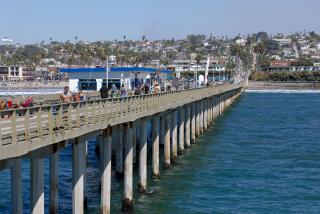Council Seeks Exemption to Save Plunge Structures
- Share via
Hoping to save some of the last distinctive features of the Mission Beach Plunge, the San Diego City Council voted Monday to seek an exemption to county safety regulations requiring demolition of stairs and a fountain pedestal at the historic pool.
The 8-0 vote came after the revelation that both county and city officials knew last year that the 1986 Department of Health Services code would require demolition of the stairs and pedestal, but said nothing about it during a hearing at which supporters of the pool were assured it would be left intact under redevelopment plans.
The 63-year-old Plunge is part of a $14.4-million development nearing completion at Belmont Park in Mission Beach. Under a project approved by the council nearly two years ago, the developers have torn down a dilapidated roller rink and the old building housing the pool to make way for shops and a farmers’ market.
Supporters of the park and the Plunge--once the site of Hollywood extravaganzas and performances by motion picture stars Esther Williams and Johnny Weissmuller--fought the development but lost in a 6-1 vote June 23, 1986.
“Everyone in this town was under the impression that pool would remain unchanged, and yet you knew it wouldn’t,” an angry Mayor Maureen O’Connor said Monday to John Melbourn, the public health engineer for the environmental health services division of the county health department.
“All of this information was available to the professionals but not to the policy-making group and not to the people in the community. That’s what’s wrong with this whole thing,” O’Connor said.
Steve Davis, managing general partner of Phase One Development, told the council that city planners also knew from architectural drawings that the steps in the deep end of the pool and the pedestal in the shallow end would have to be removed. After assurances that the pool would remain essentially intact, the developer was given a building permit after the hearing last March.
The health department has been trying for months to get the developer to remove the steps and pedestal, claiming both pose safety hazards to swimmers. The steps, built in 1925, are far too narrow to meet current safety codes, and the protruding pedestal could be struck by a swimmer, the department says.
Davis, whose workers are nearing completion on the new building housing the pool, brought the matter to the council Monday, asking that the council either allow removal of the structures or pay the $20,000 extra cost of removing them by hand once the building is complete.
The developer also asked that the city indemnify him and the pool operator for any losses stemming from a lawsuit filed if a swimmer were injured on one of the structures.
Davis noted that much of the pool will remain as it was, including most of the tile on its floor and around its edges.
O’Connor, who said she learned to swim at the Plunge and later was a lifeguard there, was one of several council members who questioned Melbourn’s contention that the steps are unsafe.
“For God’s sake, please let some memories stand in this town,” she said.
“How many people have been hurt in the Plunge in 62 years?” asked Councilwoman Gloria McColl.
Citing the passage in November of Proposition G, which limits development at Belmont Park, speakers also urged the council to find a way to avoid the county safety regulations, despite Melbourn’s claim that there is no way the county can waive the requirements.
With Councilman Bruce Henderson abstaining, the council voted unanimously to seek passage of a bill in the Legislature that would exempt the Plunge from the regulations and to work with the county Board of Supervisors to find an escape mechanism. Henderson, who represents the Mission Beach area, did not vote because he once owned stock in San Diego Gas and Electric Co., which has an interest in Phase One Development.
The council also reluctantly agreed to pay Davis for the expense of delaying removal of the steps and pedestal and to protect him from losses due to lawsuits.
It also postponed discussion until March 21 of a Proposition G provision that allows it to determine whether the developer had the right to go forward with the project when ground was broken. Because the project is almost complete, the discussion is probably moot, and the city could stop the project only by filing a lawsuit, according to Davis’ attorney, Craig Beam.
More to Read
Sign up for Essential California
The most important California stories and recommendations in your inbox every morning.
You may occasionally receive promotional content from the Los Angeles Times.













